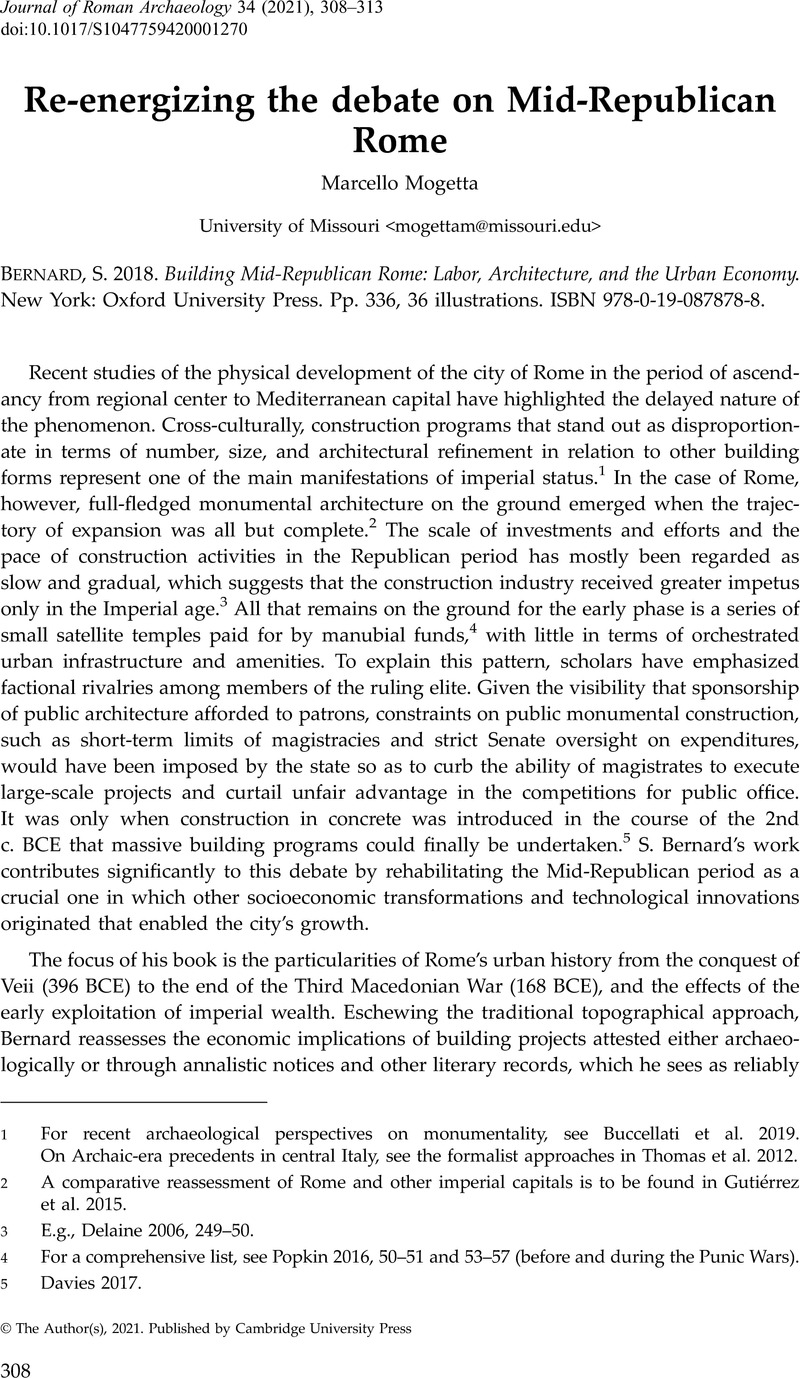No CrossRef data available.
Article contents
Re-energizing the debate on Mid-Republican Rome - S. Bernard 2018. Building Mid-Republican Rome: Labor, Architecture, and the Urban Economy. New York: Oxford University Press. Pp. 336, 36 illustrations. ISBN 978-0-19-087878-8.
Published online by Cambridge University Press: 22 January 2021
Abstract
An abstract is not available for this content so a preview has been provided. Please use the Get access link above for information on how to access this content.

- Type
- Book Review
- Information
- Copyright
- Copyright © The Author(s), 2021. Published by Cambridge University Press
References
Attema, P. A. 2018. “Urban and rural landscapes of the Pontine region (central Italy) in the late Republican period, economic growth between colonial heritage and elite impetus.” BABesch 93: 143–64.Google Scholar
Buccellati, F., Hageneuer, S., van der Heyden, S., and Levenson, F., eds. 2019. Size Matters: Understanding Monumentality across Ancient Civilizations. Bielefeld: De Gruyter.CrossRefGoogle Scholar
Capanna, M. C., and Carafa, P.. 2009. “Il progetto ‘Archeologia del suburbio di Roma’ per la ricostruzione dei paesaggi agrari antichi.” In Suburbium, 2. Il suburbio di Roma dalla fine dell'età monarchica alla nascita del sistema delle ville (V–II secolo a.C.), ed. Jolivet, V., Pavolini, C., Tomei, M. A., and Volpe, R., 27–39. Collection de l’École française de Rome 419. Rome: Quasar.Google Scholar
Cifarelli, F. M., Gatti, S., and Palombi, D., eds. 2019. Oltre “Roma medio repubblicana.” Il Lazio fra i Galli e la battaglia di Zama. Atti del Convegno Internazionale, Roma 7–8–9 Giugno 2017. Rome: Edipuglia.Google Scholar
Davies, P. E. J. 2017. “A Republican dilemma: City or state? Or, the concrete revolution revisited.” PBSR 85: 71–107.Google Scholar
DeLaine, J. 2006. “The cost of creation: Technology at the service of construction.” In Innovazione tecnica e progresso economico nel mondo romano. Atti degli incontri capresi di storia dell'economia antica (Capri 13–16 Aprile 2003), ed. Lo Cascio, E., 237–52. Bari: Edipuglia.Google Scholar
Diffendale, D. P., Marra, F., Gaeta, M., and Terrenato, N.. 2018. “Combining geochemistry and petrography to provenance Lionato and Lapis Albanus tuffs used in Roman temples at Sant'Omobono, Rome, Italy.” Geoarchaeology 34: 187–99.CrossRefGoogle Scholar
Di Giuseppe, H. 2020. “The protohistoric to late Republican landscapes of the middle Tiber valley.” In The Changing Landscapes of Rome's Northern Hinterland: The British School at Rome's Tiber Valley Project, ed. Patterson, H., Witcher, R., and Di Giuseppe, H., 74–115. Archaeopress Roman Archaeology 70. Oxford: Archaeopress.Google Scholar
Ellis, S. J. R. 2018. The Roman Retail Revolution: The Socio-Economic World of the Taberna. Oxford: Oxford University Press.CrossRefGoogle Scholar
Fulminante, F. 2014. The Urbanisation of Rome and Latium Vetus: From the Bronze Age to the Archaic Era. Cambridge: Cambridge University Press.Google Scholar
Gutiérrez, G., Terrenato, N., and Otto, A.. 2015. “Imperial cities.” In The Cambridge World History, Volume III: Early Cities in Comparative Perspective, 4000 BCE–1200 CE, ed. Yoffee, N., 532–45. Cambridge: Cambridge University Press.CrossRefGoogle Scholar
Maschek, D. 2016. “Quantifying monumentality in a time of crisis: Building materials, labour force and building costs in late Republican central Italy.” In Arqueología de la construcción V: Man-Made Materials, Engineering and Infrastructure. Proceedings of the 5th International Workshop on the Archaeology of Roman Construction, Oxford, April 11–12, 2015, ed. DeLaine, J., Camporeale, S., and Pizzo, A., 317–29. Anejos ArchEspArq 77. Madrid: Consejo Superior de Investigaciones Científicas.Google Scholar
Maschek, D. 2020. “Assessing the economic impact of building projects in the Roman world: The case of late Republican Italy.” In Quantitative Studies and Production Cost of Roman Construction, ed. Courault, C. and Márquez, C., 45–67. Córdoba: UCO Press, Editorial Universidad de Córdoba.Google Scholar
Marra, F., D'Ambrosio, E., Gaeta, M., and Mattei, M.. 2018. “The geochemical fingerprint of Tufo Lionato blocks from the Area Sacra di Largo Argentina: Implications for the chronology of volcanic building stones in ancient Rome.” Archaeometry 60: 641–59.CrossRefGoogle Scholar
Olcese, G., ed. 2013. Immensa aequora workshop. Ricerche archeologiche, archeometriche e informatiche per la ricostruzione dell'economia e dei commerci nel bacino occidentale del Mediterraneo (metà IV sec. a.C.–I sec. d.C.). Atti del convegno: Roma 24–26 gennaio 2011. Rome: Quasar.Google Scholar
Popkin, M. L. 2016. The Architecture of the Roman Triumph: Monuments, Memory, and Identity. New York: Cambridge University Press.CrossRefGoogle Scholar
Roselaar, S. 2019. Italy's Economic Revolution: Integration and Economy in Republican Italy. Oxford: Oxford University Press.CrossRefGoogle Scholar
Sewell, J. 2016. “Higher-order settlements in early Hellenistic Italy: A quantitative analysis of a new archaeological database.” AJA 120: 603–30.CrossRefGoogle Scholar
Terrenato, N. 2019. The Early Roman Expansion into Italy: Elite Negotiation and Family Agendas. Cambridge: Cambridge University Press.CrossRefGoogle Scholar
Thomas, M. L., Meyers, G. E., and Elund Berry, I. E. M., eds. 2012. Monumentality in Etruscan and Early Roman Architecture. Ideology and Innovation. Austin: University of Texas Press.Google Scholar




